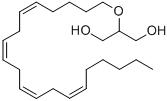- Chemical Name:Noladin ether
- CAS No.:222723-55-9
- Molecular Formula:C23H40O3
- Molecular Weight:364.5619
- Hs Code.:
- UNII:0D295FLV8W
- DSSTox Substance ID:DTXSID901018178
- Nikkaji Number:J778.939D
- Wikipedia:2-Arachidonyl_glyceryl_ether
- Wikidata:Q3877880
- Pharos Ligand ID:FPUHP84T84YA
- Metabolomics Workbench ID:5779
- ChEMBL ID:CHEMBL146346
- Mol file:222723-55-9.mol
Synonyms:2-arachidonyl glyceryl ether;noladin ether






